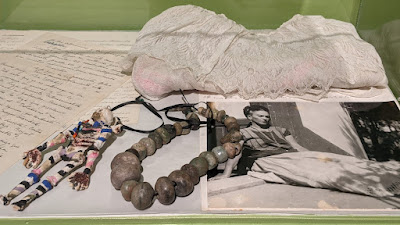Frida Kahlo's Garden...
Frida Kahlo’s Garden (Sept. 1 – Oct. 20, 2021) exhibit at the William D. Cannon Art Gallery is one that should not be missed.
Frida Kahlo (1907-1954) is revered today as one of the most significant artists of the twentieth century. Her body of work, consisting of some 250 paintings (55 of which were self portraits) and drawings, is at once intensely personal and universal in scope. We knew very little about her. By spending the afternoon with her art, treasures, clothes and photos, we began to better understand the complicated and very talented Frida. What a wealth of information gained at our favorite (and free) art gallery in Carlsbad.Kahlo's works are filled with colorful and compelling depictions of flowers, foliage, and fruits, many native to Mexico. Her choice of botanical imagery, often combined with representations of Mexico's history and culture, reflects the embrace of archetypal indigenous and natural elements that defined art in the decades following the Mexican Revolution (1910-1920), when cultural preferences shifted away from a more European aesthetic and embraced symbols of a new nation.
Steve appreciated Frida's unique upbringing. Her intense interest in the natural world likely originated in her educational grounding in positivism, the reigning intellectual tradition during her formative years as a student at the National Preparatory School. Mexican positivism, which was based on the work of French philosopher Auguste Comte, prioritized empirical observation, sourcing knowledge through one's senses, and an approach grounded in the natural sciences. Important attention was also given at the time to studying the nation's natural resources, including plants and nature. Kahlo's apparent knowledge of the medicinal and culinary properties of plants, fruits, and vegetables and her sophisticated understanding of pre-Hispanic religion and cosmology, not to mention Judaism, Hinduism, and Buddhism among other traditions, exceeded that of her peers, and her attention to detail and plant morphology in her works suggests a deep engagement with the natural world and familiarity with botanical study.
For those who know me, you won't be surprised that my favorite piece was Self-Portrait Inside a Sunflower (1954).
Each element of this painting expresses Kahlo's nationalist view, identifying herself with the natural world of her home country (sunflowers are native to western North America and northern Mexico). Kahlo's face is surrounded by sunflower petals. In many pre-Hispanic cultures, the yellow-gold petals of sunflowers were associated with the sun deity.
Some works were less easy for me to grasp. Still Life with Parrot and Flag Naturaleza (1951) is one. There were many thought provoking paintings here, demanding further study.
Not a huge surprise was Frida's 1931 Portrait of Luther Burbank (1849-1926), an American horticulturalist, and someone I have blogged about recently. Knowing her love of everything botanical, why wouldn't she admire Mr. Burbank? In this painting Burbank's body merges with a tree, an example of Kahlo's use of hybridity. When Burbank died, he was buried under the Cedar of Lebanon tree that he had planted from seed in his yard, nourishing the life of his tree with his human remains.
I knew of her great love but I never really knew. "When it comes to telling the story of the complex relationship between Frida Kahlo and Diego Rivera, historians invariably reach for the same set of biographical soundbites: his early career in Paris in the 1910s as a Cubist and her childhood struggles with polio; their fleeting first acquaintance in 1922 when she was just 15 and he was 37; the bus accident three years later that shattered her spine, pelvis, collarbone and ribs; her discovery of painting as salvation while she was bedridden and recuperating; their re-acquaintance in 1927 and his early awe at her talent; his affairs and her miscarriages; their divorce in 1939 and remarriage a year later."
Through all that, they made a life together for 25 years.
Kahlo possessed a keen appreciation for the beauty and variety of Mexico's flora and fauna, an interest evident in the garden and decoration of her home, Casa Azul, as well as in the complex use of plant imagery in her paintings. By looking at Frida's life and work through a horticultural lens, we can better appreciate the living, changing garden that reflected her many passions. Kahlo delighted in nature. Together with Diego Rivera, she crafted an immersive world that was a source of comfort and an artistic haven.
Oh, and she dressed pretty cutely, too. Frida Kahlo's wardrobe, especially the signature dress worn by women from the Isthmus of Tehuantepec in the Mexican state of Oaxaca, stood out during her lifetime and continues to occupy the popular imagination today.
This region of Mexico resisted Spanish rule during the colonial period and the women there earned a reputation of being strong and independent. These clothes became a fundamental part of her identity and made a clear statement honoring Mexico's native heritage.
In addition to gardening, painting and partying, Frida Kahlo and Diego Rivera reportedly collected tens of thousands of Mexican folk art pieces from around the country as well as Aztec and other pre-Hispanic indigenous artifacts. Many were displayed at Casa Azul: in the house, on terraces and balconies, in the gardens, and on the Aztec-style pyramid in the courtyard. Other pieces were used for tasks like cooking and serving meals.
Frida left a legacy in many ways. She kept a diary in the final decade of her life, from 1944-1954. She filled it with colorful sketches of Mexican culture, plants, and self-portraits. In the self-portrait on the left, she appears with the sun and moon, rooted in the earth.
This complex, strong, interesting woman demands a more thorough look into her life. I am very intrigued and eager to learn more.
“At the end of the day, we can endure much more than we think we can.” ― Frida Kahlo


















1 comments:
Such an amazing museum! We will get there within the next few weeks! Super excited. Thanks for the info!
Post a Comment